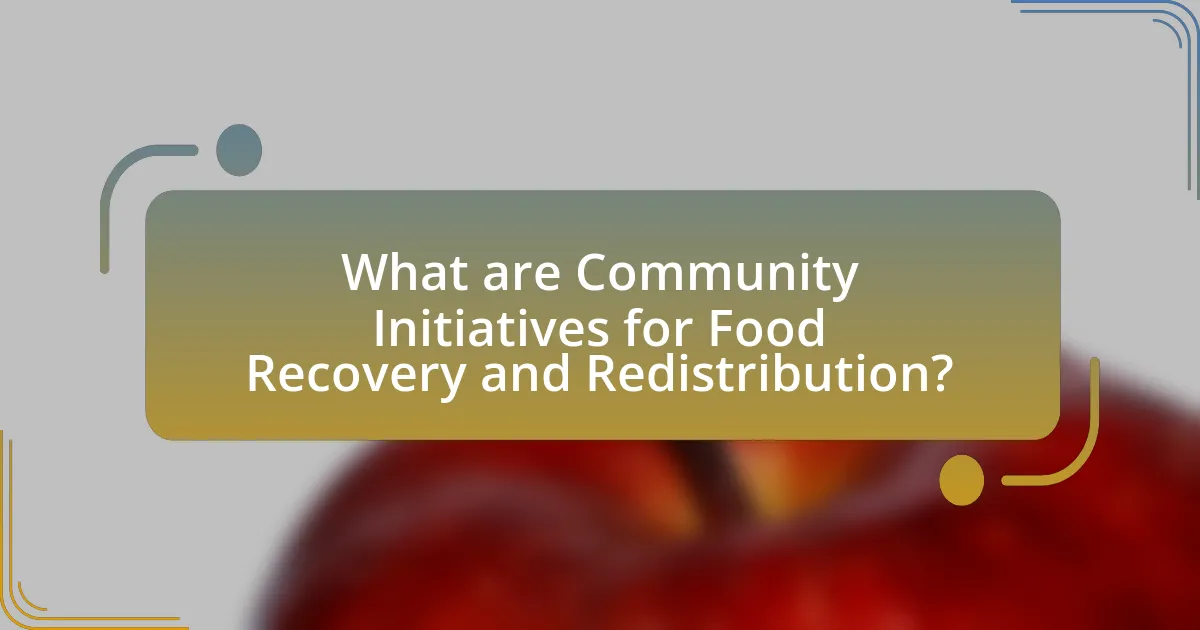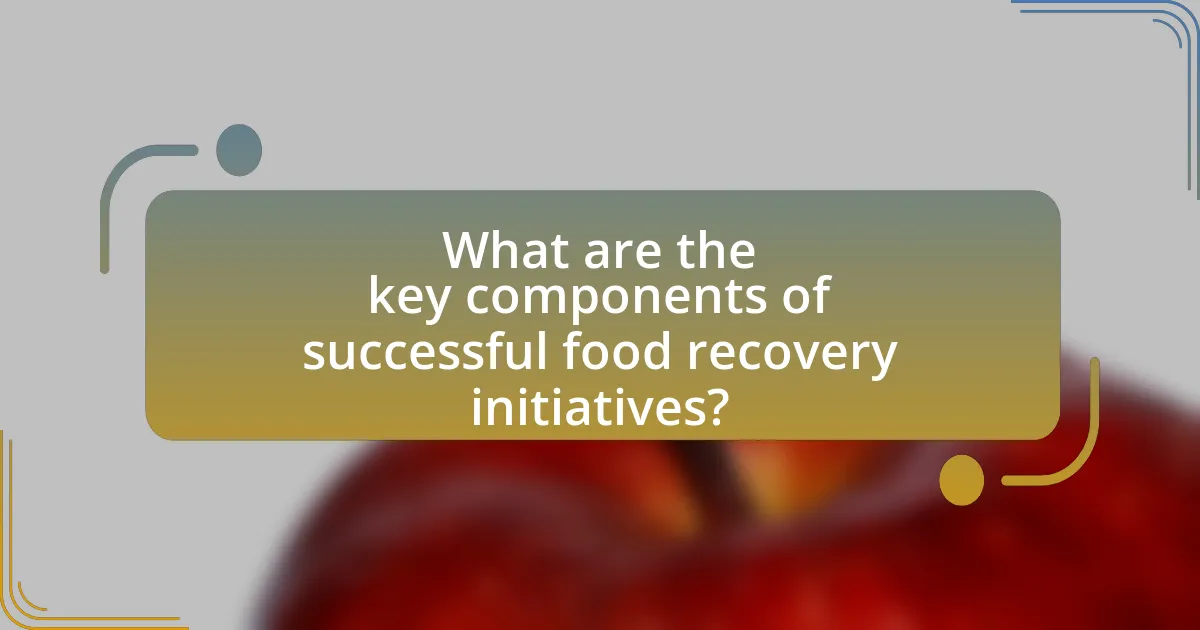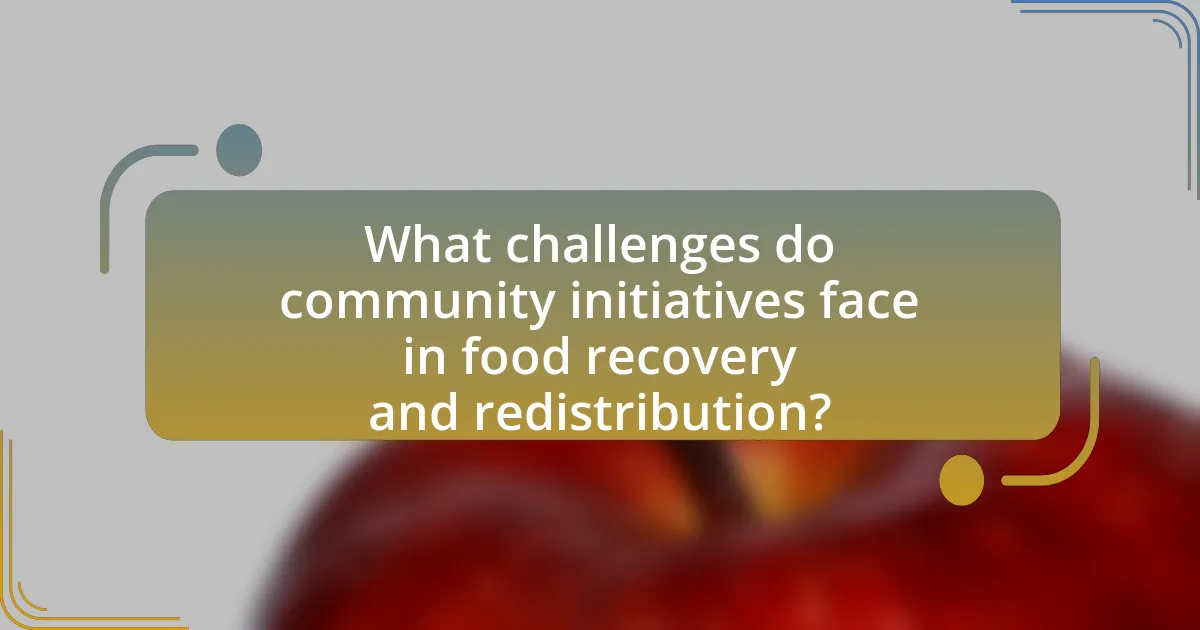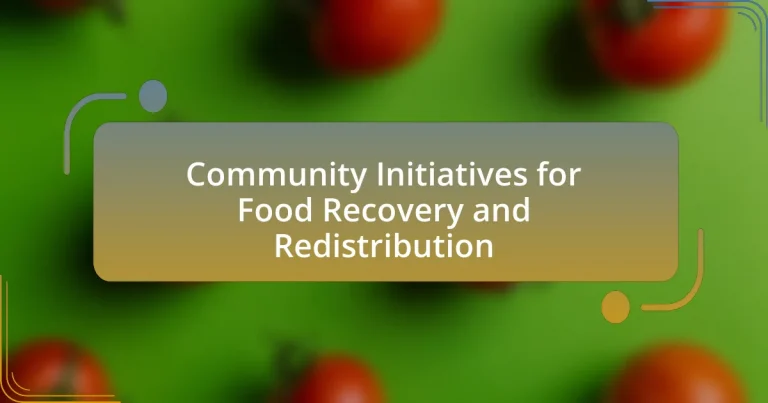Community initiatives for food recovery and redistribution are organized efforts aimed at minimizing food waste by collecting surplus food and redirecting it to individuals facing food insecurity. These initiatives involve partnerships among local businesses, food banks, non-profit organizations, and volunteers, addressing the significant issue of food waste, which accounts for approximately 30-40% of the food supply in the United States. The article explores how these initiatives operate, the types of food waste targeted, the impact on food security, and the challenges faced, including logistical issues and regulatory barriers. Additionally, it highlights successful examples and best practices that enhance the effectiveness of food recovery efforts, emphasizing the importance of community engagement and education in promoting sustainable food systems.

What are Community Initiatives for Food Recovery and Redistribution?
Community initiatives for food recovery and redistribution are organized efforts aimed at reducing food waste by collecting surplus food from various sources and redistributing it to those in need. These initiatives often involve partnerships between local businesses, food banks, non-profit organizations, and volunteers to ensure that edible food that would otherwise be discarded is redirected to support community members facing food insecurity. For example, according to the USDA, approximately 30-40% of the food supply in the United States is wasted, highlighting the critical need for effective food recovery systems that can mitigate this issue while addressing hunger.
How do these initiatives address food waste?
Community initiatives for food recovery and redistribution address food waste by facilitating the collection and redistribution of surplus food to those in need. These initiatives often involve partnerships with local businesses, farms, and food banks to divert edible food that would otherwise be discarded. For example, organizations like Feeding America report that they help recover billions of pounds of food each year, significantly reducing waste while providing meals to millions of individuals facing food insecurity. By creating efficient networks for food recovery, these initiatives not only minimize waste but also promote social equity and sustainability within communities.
What types of food waste are most commonly targeted?
The types of food waste most commonly targeted include surplus food from retailers, unsold food from restaurants, and food that is discarded due to cosmetic imperfections. Retailers often have excess inventory that exceeds demand, leading to significant waste. Restaurants frequently generate waste from over-preparation or unserved meals. Additionally, food that does not meet aesthetic standards, such as bruised fruits and vegetables, is often discarded despite being perfectly edible. According to the Food Waste Reduction Toolkit by the USDA, approximately 30-40% of the food supply in the United States is wasted, highlighting the importance of targeting these specific types of food waste for recovery and redistribution efforts.
How do these initiatives measure their impact on food waste reduction?
Initiatives measure their impact on food waste reduction through quantitative metrics such as the volume of food diverted from landfills, the number of meals provided to those in need, and the reduction in greenhouse gas emissions associated with food waste. For example, organizations like Feeding America track the pounds of food rescued and redistributed, reporting that in 2020, they provided over 6 billion meals, which directly correlates to a significant decrease in food waste. Additionally, some initiatives utilize surveys and data analytics to assess behavioral changes in food consumption and waste practices among participants, further validating their effectiveness in reducing food waste.
Why are community initiatives important for food security?
Community initiatives are crucial for food security because they enhance local access to nutritious food and foster resilience against food shortages. These initiatives often involve local food production, distribution networks, and educational programs that empower communities to manage their food resources effectively. For instance, community gardens can increase food availability and promote healthy eating habits, while food banks and redistribution programs help reduce food waste and support vulnerable populations. Research indicates that communities with strong local food systems experience lower rates of food insecurity, demonstrating the effectiveness of these initiatives in addressing hunger and improving overall community health.
How do these initiatives support vulnerable populations?
Community initiatives for food recovery and redistribution support vulnerable populations by providing access to nutritious food that would otherwise go to waste. These initiatives directly address food insecurity, which affects millions of individuals, particularly low-income families and marginalized communities. For example, organizations like Feeding America report that food recovery programs can distribute millions of pounds of food annually, significantly alleviating hunger in at-risk populations. By connecting surplus food from retailers and producers to local food banks and shelters, these initiatives ensure that vulnerable groups receive essential resources, improving their overall health and well-being.
What role do local organizations play in enhancing food security?
Local organizations play a crucial role in enhancing food security by facilitating access to nutritious food and supporting local food systems. These organizations often implement programs that redistribute surplus food from businesses to those in need, thereby reducing food waste and addressing hunger. For example, food banks and community kitchens work directly with local farmers and grocery stores to collect excess food, which is then distributed to vulnerable populations. According to Feeding America, food banks provided over 6 billion meals in 2020, demonstrating their significant impact on food security. Additionally, local organizations often engage in educational initiatives that promote sustainable agricultural practices and nutrition awareness, further strengthening community resilience against food insecurity.

What are the key components of successful food recovery initiatives?
Successful food recovery initiatives consist of collaboration, effective logistics, community engagement, and education. Collaboration among stakeholders, including food donors, nonprofits, and volunteers, ensures a streamlined process for food recovery. Effective logistics involve efficient transportation and storage solutions to minimize food spoilage, which is critical as approximately 30-40% of the food supply in the U.S. is wasted. Community engagement fosters local support and participation, enhancing the initiative’s reach and impact. Education raises awareness about food waste and recovery, empowering individuals to contribute actively. These components collectively enhance the effectiveness and sustainability of food recovery efforts.
How do partnerships enhance the effectiveness of these initiatives?
Partnerships enhance the effectiveness of community initiatives for food recovery and redistribution by pooling resources, expertise, and networks. Collaborative efforts between local governments, non-profits, and businesses increase the reach and impact of food recovery programs, allowing for more efficient logistics and distribution channels. For instance, partnerships can facilitate access to larger food supplies and reduce waste through shared infrastructure, such as transportation and storage facilities. Research indicates that initiatives involving multiple stakeholders can lead to a 30% increase in food recovery rates, demonstrating the tangible benefits of collaboration in addressing food insecurity.
What types of organizations typically collaborate in these efforts?
Organizations that typically collaborate in community initiatives for food recovery and redistribution include non-profit organizations, local government agencies, food banks, community-based organizations, and businesses in the food industry. Non-profit organizations often lead these initiatives by mobilizing volunteers and resources to collect and distribute surplus food. Local government agencies may provide funding and support for these efforts, while food banks serve as central hubs for food distribution. Community-based organizations engage local residents and stakeholders to ensure that food recovery efforts meet the needs of the community. Businesses in the food industry, such as grocery stores and restaurants, often partner by donating excess food, thereby reducing waste and supporting local food security.
How can community engagement improve initiative outcomes?
Community engagement can significantly improve initiative outcomes by fostering collaboration, enhancing trust, and ensuring that initiatives are tailored to the specific needs of the community. When community members actively participate in food recovery and redistribution initiatives, they contribute valuable insights that can lead to more effective strategies and solutions. For instance, a study by the Food and Agriculture Organization found that community-driven approaches in food programs resulted in a 30% increase in food recovery efficiency compared to top-down methods. This demonstrates that involving the community not only boosts participation but also leads to more sustainable and impactful outcomes in food recovery efforts.
What strategies are used for food redistribution?
Food redistribution strategies include food banks, community fridges, and direct donation programs. Food banks collect surplus food from retailers and manufacturers, then distribute it to those in need through partner agencies, serving millions annually; for instance, Feeding America reported distributing over 6 billion meals in 2020. Community fridges allow individuals to share excess food within neighborhoods, promoting local access and reducing waste. Direct donation programs enable businesses and individuals to donate food directly to shelters and community organizations, enhancing food security and reducing food waste. These strategies collectively address hunger and promote sustainability in food systems.
How do food banks and pantries operate within these initiatives?
Food banks and pantries operate within community initiatives for food recovery and redistribution by collecting surplus food from various sources, including grocery stores, restaurants, and farms, and distributing it to individuals and families in need. These organizations often collaborate with local agencies and volunteers to ensure efficient logistics and outreach, maximizing the amount of food recovered and minimizing waste. For example, Feeding America, a nationwide network of food banks, reports that it provides over 4 billion meals annually through partnerships with more than 200 food banks and 60,000 food pantries, demonstrating the scale and impact of these initiatives in addressing food insecurity.
What innovative methods are being used for food distribution?
Innovative methods for food distribution include the use of mobile apps, community fridges, and food recovery networks. Mobile apps like Too Good To Go connect consumers with surplus food from restaurants and stores, allowing users to purchase food at reduced prices, thereby minimizing waste. Community fridges provide accessible locations for individuals to share excess food, fostering local sharing and reducing food insecurity. Food recovery networks, such as City Harvest, coordinate the collection and redistribution of surplus food from businesses to food banks and shelters, effectively addressing hunger while reducing waste. These methods demonstrate a growing trend towards technology-driven solutions and community engagement in food distribution.

What challenges do community initiatives face in food recovery and redistribution?
Community initiatives in food recovery and redistribution face several challenges, including logistical issues, regulatory barriers, and community engagement. Logistical challenges arise from the need for efficient transportation and storage of perishable food items, which can lead to food spoilage and waste. Regulatory barriers often include complex food safety laws that can discourage businesses from donating food, as they fear liability. Additionally, engaging the community is crucial; initiatives may struggle to mobilize volunteers or secure consistent participation, which can hinder their effectiveness. According to a report by the Food Waste Reduction Alliance, 40% of food in the U.S. is wasted, highlighting the urgency of addressing these challenges to improve food recovery efforts.
How do logistical issues impact food recovery efforts?
Logistical issues significantly hinder food recovery efforts by creating barriers in the transportation, storage, and distribution of surplus food. For instance, inadequate transportation resources can lead to delays in picking up food donations, resulting in spoilage and waste. Additionally, a lack of proper storage facilities can compromise food safety, making it difficult to maintain the quality of recovered food. According to a report by the Food Waste Reduction Alliance, logistical challenges account for approximately 30% of food waste in recovery initiatives, highlighting the critical need for efficient systems to enhance food recovery efforts.
What are common barriers to effective food distribution?
Common barriers to effective food distribution include logistical challenges, lack of infrastructure, and regulatory constraints. Logistical challenges arise from inefficient transportation systems and inadequate storage facilities, which hinder timely delivery of food. Lack of infrastructure, particularly in rural or underserved areas, limits access to necessary resources for distribution. Regulatory constraints, such as food safety laws and liability issues, can complicate the redistribution process, making it difficult for organizations to operate effectively. These barriers collectively impede the efficiency and reach of food distribution efforts, impacting food recovery and redistribution initiatives.
How can technology help overcome these challenges?
Technology can help overcome challenges in community initiatives for food recovery and redistribution by enhancing efficiency and connectivity among stakeholders. For instance, mobile applications can facilitate real-time communication between food donors, food banks, and recipients, ensuring timely pickups and reducing food waste. Additionally, data analytics can optimize logistics by predicting demand and supply patterns, allowing organizations to allocate resources more effectively. A study by the Food Waste Reduction Alliance found that technology-driven solutions can increase food recovery rates by up to 30%, demonstrating the significant impact of technological integration in addressing food insecurity and waste.
What legal and regulatory considerations must be addressed?
Legal and regulatory considerations for community initiatives in food recovery and redistribution include compliance with food safety laws, liability protections, and local health regulations. Food safety laws, such as the Food Safety Modernization Act, mandate that food handling and distribution meet specific safety standards to prevent contamination. Liability protections, like the Good Samaritan Food Donation Act, encourage food donors by limiting their liability when donating food in good faith. Additionally, local health regulations may require permits for food distribution activities and adherence to sanitation standards. These considerations ensure that initiatives operate legally and safely while promoting food recovery efforts.
How do liability laws affect food donation practices?
Liability laws significantly influence food donation practices by providing legal protections to donors, which encourages them to contribute surplus food. Specifically, the Good Samaritan Food Donation Act in the United States protects food donors from liability when donating food in good faith, as long as the food is safe for consumption. This legal framework reduces the fear of lawsuits related to foodborne illnesses, thereby increasing the volume of food donations. According to the U.S. Department of Agriculture, this act has led to a notable increase in food recovery efforts, as it reassures businesses and individuals that they will not be held liable for unintentional harm resulting from their donations.
What regulations govern food safety in recovery initiatives?
Regulations governing food safety in recovery initiatives primarily include the Food Safety Modernization Act (FSMA) and local health department guidelines. The FSMA, enacted in 2011, emphasizes preventive measures to ensure the safety of food throughout the supply chain, including recovery efforts. Local health departments often establish specific regulations that dictate how food can be collected, stored, and redistributed to prevent contamination and ensure public health. These regulations are crucial for maintaining safety standards and protecting consumers during food recovery initiatives.

What are some successful examples of community initiatives for food recovery?
Successful examples of community initiatives for food recovery include Food Rescue US, City Harvest, and the Community Food Bank of New Jersey. Food Rescue US utilizes a mobile app to connect food donors with local nonprofits, successfully rescuing millions of pounds of food since its inception. City Harvest, based in New York City, has been recovering surplus food from restaurants and grocery stores for over 35 years, delivering it to community food programs, which has resulted in the recovery of over 1.5 million pounds of food annually. The Community Food Bank of New Jersey operates a statewide network that redistributes food to over 1,000 partner agencies, serving more than 1 million people each year, demonstrating the effectiveness of organized food recovery efforts.
How have specific programs made a measurable impact?
Specific programs in community initiatives for food recovery and redistribution have significantly reduced food waste and increased food access for underserved populations. For instance, the Food Rescue program in San Francisco has diverted over 1.5 million pounds of food from landfills annually, redistributing it to local food banks and shelters. This initiative not only minimizes environmental impact but also provides nutritious meals to thousands of individuals in need, demonstrating a clear measurable impact on both food waste reduction and community health.
What lessons can be learned from these successful initiatives?
Successful community initiatives for food recovery and redistribution demonstrate the importance of collaboration among local stakeholders. These initiatives often involve partnerships between non-profits, local businesses, and government entities, which enhance resource sharing and increase efficiency in food distribution. For example, the Food Rescue Network in Canada has shown that engaging diverse community members leads to innovative solutions and greater impact, as evidenced by their ability to recover over 1.5 million pounds of food annually. Additionally, effective communication and awareness campaigns are crucial, as they educate the public about food waste and encourage participation, leading to a more sustainable food system.
What best practices can be adopted for new initiatives?
Best practices for new initiatives in community food recovery and redistribution include establishing clear goals, engaging stakeholders, and implementing effective communication strategies. Clear goals provide direction and measurable outcomes, while engaging stakeholders such as local businesses, nonprofits, and volunteers fosters collaboration and resource sharing. Effective communication ensures that all parties are informed and aligned, which is crucial for the success of initiatives. Research shows that initiatives with strong stakeholder engagement and clear objectives are more likely to achieve sustainable impact, as evidenced by successful programs like City Harvest in New York, which has effectively redistributed millions of pounds of food through community partnerships.
How can communities effectively mobilize resources for food recovery?
Communities can effectively mobilize resources for food recovery by establishing partnerships with local businesses, non-profits, and government agencies to create a coordinated network for food redistribution. This collaboration enables the pooling of resources, such as transportation and storage facilities, which are essential for collecting surplus food. For instance, organizations like Feeding America have demonstrated that community-based food recovery programs can significantly reduce food waste while addressing food insecurity, as they successfully distribute millions of pounds of food annually through local partnerships. Additionally, implementing community awareness campaigns can engage volunteers and encourage local residents to participate in food recovery efforts, further enhancing resource mobilization.
What role does education play in promoting food recovery initiatives?
Education plays a crucial role in promoting food recovery initiatives by raising awareness about food waste and teaching effective recovery practices. Through educational programs, individuals and communities learn the importance of reducing food waste, understanding food safety, and implementing recovery strategies such as donation and composting. For instance, studies show that educational interventions can lead to a significant increase in food donation rates, as participants become more informed about the logistics and benefits of food recovery. Additionally, organizations like Feeding America provide resources and training that empower communities to establish their own food recovery programs, demonstrating the direct impact of education on enhancing food recovery efforts.
What practical steps can individuals take to support food recovery efforts?
Individuals can support food recovery efforts by donating surplus food to local food banks and shelters. This action directly addresses food waste and helps feed those in need. According to the USDA, approximately 30-40% of the food supply in the United States is wasted, highlighting the importance of redistributing excess food. Additionally, individuals can volunteer their time at food recovery organizations, which often rely on community support to operate effectively. Engaging in awareness campaigns about food waste and recovery can also amplify the impact, as informed communities are more likely to participate in food recovery initiatives.


